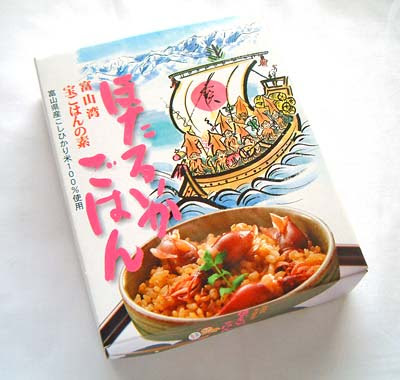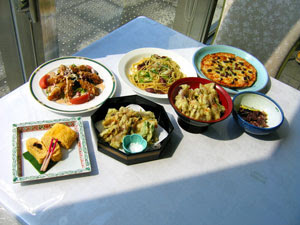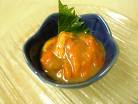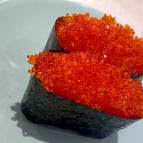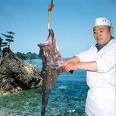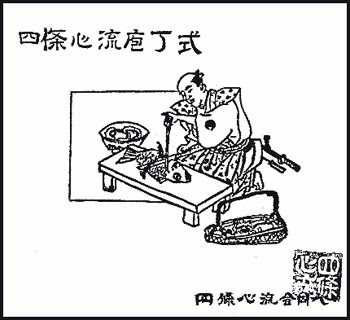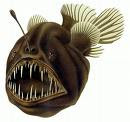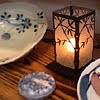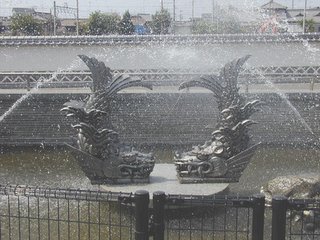[ . BACK to WORLDKIGO TOP . ]
! SEARCH THIS BLOG !
::::::::::::::::::::::::::::::::::::::::::::::::::::::::::::::::::::::::::::::::::::::::::::::::::::
COOKING METHODS
The most important methods for preparing food are introduced here.
::::::::::::::::::::::::::::::::::::::::::::::::::::::::::::::::::::::::::::::::::::::::::::::::::::
aburadooshi あぶらどおし【油通し】 frying food quickly
usually before simmering or other cooking methods. Often done with Chinese cooking The outside gets a small membrane that will not let the taste leek out later. Usually done at 150 to 160 degrees centigrade.
aburanuki あぶらぬき【油抜き】 to drain off oil
after frying and deep-frying. Put it in hot water for a moment to drain of the oily taste.
aburu あぶる【焙る/炙る】 to per-heat
Both sides of a food are heatet for a moment over a grill or gas flames to get rid of excess moisture and warm the food.
Nori get tasty after this treatment.
::::::::::::::::::::::::::::::::::::::::::::::::::::::::::::::::::::::::::::::::::::::::::::::::::::
Aemono あえ物、和え物 (あえもの) Japanese Dressing
... Namasu dressing 膾 , 鱠, なます
::::::::::::::::::::::::::::::::::::::::::::::::::::::::::::::::::::::::::::::::::::::::::::::::::::
Ageru 揚げる (あげる) frying, stir-frying
this word is also used for tenpura and furai (fried shrimp)
pfannenrühren
Kara-age and Tatsuta-age ... deep-frying 唐揚げ / 竜田揚げ
Kushiage, kushi-age 串揚げ deep-fried food pieces on bamboo sticks
agebitashi あげびたし【揚(げ)浸し】first frying and then marinating in flavored broth for some time.
With eggplants. Fish get softer bones when prepared like this.
agedama あげだま【揚(げ)玉】bits of fried batter
for example after cooking some tempura (tempura kasu, tenkasu 天かす)
in Kanto, these are put into udon soup )Tanuki udon.
Also put into miso soup.
agedashi あげだし【揚(げ)出し】deep fried food with a batter is placed in broth, some yakumi spices are added and shredded daikon radish, to sap off the oil.
Usually for Tofu (agedashidoofu) and eggplants (agedashi nasu 揚げだし茄子)
. . . CLICK here for eggplant Photos !
ageni, age-ni あげに【揚(げ)煮】 first frying, then simmering
Fish, meat or vegetables.
::::::::::::::::::::::::::::::::::::::::::::::::::::::::::::::::::::::::::::::::::::::::::::::::::::
Aku nuki, akunuki あくぬき (灰汁抜き) removing bitterness
the vegetables are often rubbed and rolled in a special liquid.
aku has an acrid, alkaline flavor.
Bitter chestnuts and acorns were treated in running water for days before eating.
Bamboo shoots need to be treated too, by boiling them with rice bran (komenuka).
Many ferns and other
sansai mountain vegetables need to be treated.
rubbing with salt, shiomomi しおもみ(塩揉み)
aku tori, akutori アク取り take off the scum from boiling food
usually a flat spoon or sieve is used
. . . CLICK here for Photos !
:::::::::::::::::::::::::::::::::::::::::::::::::::::::::::::::::::::::::::::::::::::::::::::::::::::
amani, ama-ni あまに【甘煮】 "sweetly simmered"
Simmering food with extra lots of sugar. Especially kabocha, sweet potatoes and beans. People in Nagasaki use a lot of sugar in the food.
amiyaki あみやき【網焼き】 grilling, broiling
when the food is placed on a metal net or squeezed between two nets.
aomi あおみ "greenness"
to add green color for decoration.
for sashimi : aojiso perilla, spinach, cucumbers, cauliflower
for dressings (aemono) : rapeseed, shungiku chrysanthemum, spinach, cucumber, mitsuba, menegi leek
for nimono simmering : sayaendoo green beans, sayaingen, rapeseed, shungiku, mizuna, kinome tree buds
for soups : mitsuba, green leek, spinach, shungiku, mizuna, mibuna, kaiwarena.
::::::::::::::::::::::::::::::::::::::::::::::::::::::::::::::::::::::::::::::::::::::::::::::::::::
aramijin あらみじん / 粗みじん cut into rough small pieces
. . . CLICK here for Photos !
araregiri あられぎり / あられ切り cut to squares like
arare pieces
especially for vegetables with a lenght of 4 to 5 cm.
ataru あたる grinding
The proper word would be
suru する【擂る】for grinding, but this has a negative feeling to it (engi ga yokunai), so its opposite ataru あたる【当たる/中る】was choosen.
Im Mörser zerreiben
suribachi すりばち【擂り鉢/摺り鉢】 earthwear mortar
. . . CLICK here for Photos !
::::::::::::::::::::::::::::::::::::::::::::::::::::::::::::::::::::::::::::::::::::::::::::::::::::
Denbu and Oboro 田麩 / おぼろ (朧)... shredded food preparations
sakura denbu
Dengaku 田楽 dance and food
pieces on skewers with miso paste
:::::::::::::::::::::::::::::::::::::::::::::::::::::::::::::::::::::::::::::::::::::::::::::::::::::
heating food
Old names of the Edo period:
the words in brackets are used now
bunka 文火 (ぶんか) low heat/flame (yowabi 弱火)
bunbuka 文武火(ぶんぶか)medium heat/flame (chuubi 中火)
buka 武火(ぶか) high heat/flame (tsuyobi 強火)
::::::::::::::::::::::::::::::::::::::::::::::::::::::::::::::::::::::::::::::::::::::::::::::::::::
Hitasu 浸す (ひたす)
soaking, steeping
Ohitashi お浸し o-hitashi 御浸し
:::::::::::::::::::::::::::::::::::::::::::::::::::::::::::::::::::::::::::::::::::::::::::::::::::::
iburi いぶり, ibusu 燻す to smoke, smoking, smoked food
kunsei 燻製 smoked food, often with cherry wood chips.
Iru いる (炒る /煎る) roasting, toasting
rösten; dörren; brennen; braten.
Preparation with little oil or whater, simply stirring the food frequently.
Kara iri からいり (乾煎り/ 空炒り), parching without using oil, dry-roasting
see ... iridoofu, iridori, iritamago.
:::::::::::::::::::::::::::::::::::::::::::::::::::::::::::::::::::::::::::::::::::::::::::::::::::::
Kanro-Ni, kanroni 甘露煮 sweet simmering
for small fish or fruit
:::::::::::::::::::::::::::::::::::::::::::::::::::::::::::::::::::::::::::::::::::::::::::::::::::::
Kiru 切る cutting Japanese food
an art in itself !
:::::::::::::::::::::::::::::::::::::::::::::::::::::::::::::::::::::::::::::::::::::::::::::::::::::
Kosu こす straining
strainer for miso, misokoshi みそこし (味噌漉し)
sarashi さらし, sarashinuno さらし布 thin cloth for straining food
:::::::::::::::::::::::::::::::::::::::::::::::::::::::::::::::::::::::::::::::::::::::::::::::::::::
Modosu もどす(戻す) rehydrating dried food, soaking dried food in water
::::::::::::::::::::::::::::::::::::::::::::::::::::::::::::::::::::::::::::::::::::::::::::::::::::
Musu むす (蒸す)steaming
dünsten, schmoren, in einer Pfanne, wenn die Lebensmittel Wasser ziehen
mushiki むしき (蒸し器) steamer
Dämpfer
mushiyaki ... 蒸し焼き steaming
dämpfen
This is a typical preparation for Chinese food items and some Japanese fish dishes.
CLICK here for PHOTOS !
jigoku mushi 地獄蒸し boiled in hot steam of a hot spring
Gokuraku Onkei 極楽温鶏 whole steamed chicken from Oita 極楽温鶏
in Dampf kochen
seiromushi, seiro mushi セイロ蒸し steamed in a
seiro steamer
a traditional seiro is made of bamboo (take seiro 竹せいろ).
Or you can use a metal pot and have two or more seiro to put on it.
. . . CLICK here for Photos !
:::::::::::::::::::::::::::::::::::::::::::::::::::::::::::::::::::::::::::::::::::::::::::::::::::::
Niru 煮る simmering
nitsuke 煮付け simmering with soy sauce, sugar and mirin
CLICK here for PHOTOS !
Hokke no nitsuke ... and Prime Minister Aso some politics !
aoni あおに【青煮】"simmering while keeping the green color"
mostly with salt and thin soy sauce.
nimono 煮物 simmered/boiled food
Gekochtes
. niuriya, niuri-ya 煮売屋 / 煮売り屋 / にうりや selling simmered, boiled food .
saiya 菜屋
niurizakaya 煮売り酒屋 selling simmered food and sake
ichizen meshiya 一膳飯屋 quick lunch vendor
ochazuke ya お茶漬け屋 selling o-chazuke
- niuribune 煮売船 / 煮売り船
inakani, inaka-ni 田舎煮 cooked food, "rural style"
vegetables boiled with soysauce and sugar, until almost all liquid is gone. Often prepared with taro.
. . . CLICK here for Photos !
. WASHOKU
suppa-ni すっぱ煮 sour simmered food
umani, uma-ni うまに 【旨煮/甘煮】 "deliciously simmered"
fish [meat] and vegetables boiled in soy sauce and sugar
. . . CLICK here for Photos !
:::::::::::::::::::::::::::::::::::::::::::::::::::::::::::::::::::::::::::::::::::::::::::::::::::::
Onigiri おにぎり rice balls
Orosu おろす grating
grating radish, daikon oroshi だいこんおろし (大根卸し)
metal grater, oroshigane おろしがね (下ろし金/卸し金), comes in many shapes, some used directly at the table for wasabi etx.
samekawa oroshi-ki 鮫皮 下ろし器 grater for shakeskin
::::::::::::::::::::::::::::::::::::::::::::::::::::::::::::::::::::::::::::::::::::::::::::::::::::
Otoshibuta おとしぶた (落とし蓋) "dropped down lid", lid resting directly on the food in a pot or pan
to simmer, poach or braise food
The lid has to be a little bit smaller than the opening of the pot or pan.
:::::::::::::::::::::::::::::::::::::::::::::::::::::::::::::::::::::::::::::::::::::::::::::::::::::
Shiokara ... salty and pugnant pickles 塩辛
Shiozuke しおづけ(塩漬(け)) preserved in salt, pickled in salt
preserve fish in salt
Einsalzen, Einlegen in Salz (Fisch, Gemüse, Eier).
Pökeln (Fleisch und Wurstwaren)
quote
Einsalzen ist neben dem Trocknen eine der ältesten Methoden zur Konservierung von Lebensmitteln. Dabei wird durch das Salz die Feuchtigkeit in den Produkten für Mikroorganismen unbrauchbar. Um zuverlässig zu wirken, muss das Salz die Lebensmittel vollständig und gleichmäßig durchdringen. Dem Salz können auch trockene Gewürze zugegeben werden, um den Geschmack zu verbessern ...
Bei einigen Produkten, z.B. Weißkohl oder grünen Bohnen, tritt durch eine genau abgemessene Salzmenge Saft aus. Die darin enthaltenen Mikroorganismen bewirken eine langsame Fermentation, bei der Zucker in Säure verwandelt wird.
Pökeln
Dabei kommt außer dem Salz noch Salpeter zum Einsatz, der die bakterienhemmende Wirkung des Salzes verstärkt.
Pökeln mit Nitritpökelsalz
© More in the WIKIPEDIA !
Shogayaki ... Ginger Roast Meat 生姜焼き
:::::::::::::::::::::::::::::::::::::::::::::::::::::::::::::::::::::::::::::::::::::::::::::::::::
Suritsubusu すりつぶす(磨り潰す/擂り潰す) crushing, mashing, grinding
groved grating mortar, suribachi すりばち(擂り鉢/摺り鉢)
:::::::::::::::::::::::::::::::::::::::::::::::::::::::::::::::::::::::::::::::::::::::::::::::::::
Tare, タレ all kinds of sauces for dipping
amadare, あまだれ 甘タレ sweet dipping sauce
gomadare, ごまだれ(胡麻垂れ) seseme sauce
misodare みそだれ 味噌タレ miso sauce
shabushabu no tare しゃぶしゃぶのタレ comes with different kinds of sauces for dipping, some are the specialities of a restaurand kept for many generations.
. . . CLICK here for Photos !
shoogadare しょうがだれ ginger sauce
wasabidare, wasabijooyu (wasabi shoyu) わさびだれ、山葵醤油 soy sauce with Japanese horseradish
tataki たたき food chopped with a knife
aji no tataki アジのたたき chopped horse mackerel
:::::::::::::::::::::::::::::::::::::::::::::::::::::::::::::::::::::::::::::::::::::::::::::::::::::
. tenpura てんぷら . 天婦羅 . 天麩羅 . 天ぷら Tenpura, Tempura .
 tenpura てんぷら . 天婦羅 . 天麩羅 .
tenpura てんぷら . 天婦羅 . 天麩羅 .
天ぷら Tenpura, Tempura
deep-fried battered food
many ingredients are deep-fried. Mostly fish and seafood and vegetables.
Even the new leaves of greet tea are made into tempura during the season 新茶の天婦羅.
The recipe for tempura was introduced to Japan by Portuguese Jesuit missionaries particularly active in the city of Nagasaki also founded by the Portuguese, during the sixteenth century (1549).
Tokugawa Ieyasu, founder and first shogun of the Tokugawa shogunate of Japan, reportedly loved tempura. Originally, tempura was a popular food eaten at street venders called 'yatai'(屋台) since the Genroku era.
Today, tempura is still a popular side dish at home, and is frequently eaten as a topping at soba stands.
© More in the WIKIPEDIA !
frittierter Fisch, frittiertes Gemüse
WASHOKU : Tenpura Tempura dishes in our BLOG
basu tenpura バス天ぷら tempura from black bass
ブラックバス天ぷら付のうどん
From Lake Biwa
Maple leaves tempura (momiji tenpura)
kinpura きんぷら 【金麩羅】
Kinpura
the coating is made with buckwheat flour. Oil from torreya nuts (kaya 榧(かや) is used for frying.
. . . CLICK here for Photos !
tenpuraya 天麩羅屋 vendor of tenpura in Edo
They were the beginning of small stalls selling "fast food" to be eaten while standing, for the fast-living workers of Edo.
 source : homepage3.nifty.com/shokubun
. Food vendors in Edo .
天麩羅の指をぎぼしへ引きなすり
source : homepage3.nifty.com/shokubun
. Food vendors in Edo .
天麩羅の指をぎぼしへ引きなすり
tenpura no yubi o giboshi e hikinasuri
he wipes his fatty tempura fingers
on the giboshi decoration
of the bridge
This senryu tells us about the carefree behaviour of the tempura cooks. Tempura was made with some flavor on the food items, but not served with sauce as it is today. Tempura dipping sauce was introduced much later in the Meiji period.
. senryu, senryū 川柳 Senryu in Edo .
. giboshi 擬宝珠 metai decoration of a railing .
:::::::::::::::::::::::::::::::::::::::::::::::::::::::::::::::::::::::::::::::::::::::::::::::::::::
WASHOKU
Tsukemono 漬物 Pickles
asazuke あさづけ【浅漬け】lightly pickled vegetables
Tsukimi, with an egg as "moon viewing" decoration
tsukudani つくだに (佃煮, つくだ煮) simmering in sweetened soy sauce
:::::::::::::::::::::::::::::::::::::::::::::::::::::::::::::::::::::::::::::::::::::::::::::::::::
Yahata-maki やはたまき (八幡巻き) goboo burdock roll
from Yahata village, Kyoto
:::::::::::::::::::::::::::::::::::::::::::::::::::::::::::::::::::::::::::::::::::::::::::::::::::
Yaku 焼く "burning, heating", baking, toasting, broiling, grilling, pan searing
this word is used for many preparations, sometimes using oil.
shichirin しちりん (七輪) small portable stove for grilling with charcoal
. . . CLICK here for Photos !
YAKU ...
Aburi-yaki, Horoku-yaki, Kara-yaki, Kimi-yaki, Miso-yaki, Namban-yaki, O-kariba-yaki, Shio-yaki, Teri-yaki and many more !
:::::::::::::::::::::::::::::::::::::::::::::::::::::::::::::::::::::::::::::::::::::::::::::::::::::
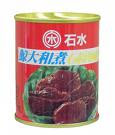 Yamatoni, Yamato-ni
Yamatoni, Yamato-ni 大和煮 simmering meat of wild animals and birds in soy sauce, sugar and ginger
for whale meat, ginger and perilla leaves are cut finely and simmered too.
CLICK here for PHOTOS !
This method evolved in the Meiji period, when meat was eaten more frequently in Japan. A procucer of canned chicken meat, Maeda 前田道方 made it famous.
In 1915 the company Meijiya 明治屋 produced canned beef.
In 1923 Mitsukoshi in Nihonbashi had bargain sales of the canned meat. The Japanese army used this canned meat too.
hogei 捕鯨(ほげい) catching whales became popular and much whale meat was produced for canning, also sheep, horse and deer, even bears and sea lions. But all this meet has a strong animal tast and needs long hours of simmering.
See .. Kujira Ekiben from Tateyama, Chiba.
. Yamato Province in Nara prefecture
Yudoshi, yudooshi ゆどおし(湯通し) blanching in boiling water
:::::::::::::::::::::::::::::::::::::::::::::::::::::::::::::::::::::::::::::::::::::::::::::::::::
*****
WASHOKU : COOKING METHODS
Zubereitung, Zubereitungen von Speisen
Methoden
:::::::::::::::::::::::::::::::::::::::::::::::::::::::::::::::::::::::::::::::::::::::::::::::::::


